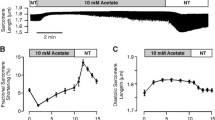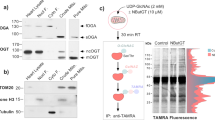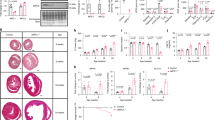Abstract
Cultured cardiac myocytes were depleted of ATP by incubation with oligomycin (1 mg/ml). Then the ability of the cells to oxidize various substrates and to restore ATP levels was studied. Following ATP depletion, the cells were found to be able to oxidize glucose given alone, but not palmitate. However, with both substrates, palmitate was oxidized in the presence of glucose and ATP recovery was enhanced. Pyruvate had a minor effect on palmitate oxidation, while acetate given alone was oxidized, but did not enhance cellular ATP content. These results show that glucose is essential for restoration of mitochondrial function and the coupling between oxidation and ATP synthesis.
Similar content being viewed by others
References
Neely JR, Morgan HE: Relationship between carbohydrate and lipid metabolism, and the energy balance of heart muscle. Ann Rev Physiol 36: 413–459, 1974
Frelin C, Pinson A, Athias P, Surville JM, Padien P: Glucose and palmitate metabolism by beating heart cells in culture. Pathol Biol 27: 45–50,1979
Liedtke AJ: Alterations of carbohydrate and lipid metabolism in the acutely ischemic heart. Prog Cardiovasc Dis 23: 321–336, 1981
Opie LH, Owen P, Riemersam RA: Relative rates of oxidation of glucose and FFA by ischaemic and nonischaemic myocardium after coronary artery ligation. Eur J Clin Invest 3: 419–435, 1973
Opie LH, Bricknell OL: Role of glycolytic flux in effect of glucose in decreasing fatty acid induced release of lactate dehydrogenase from isolated coronary ligated rat heart. Cardiovasc Res 13: 693–702, 1979
Opie LH: The Heart, Physiology and Metabolism (2nd ed). Raven Press, New York, 1991, p 430
Schwaiger M, Schelbert HR, Keen R, Vinten-Johansen J, Hansen H, Selin C, Bario G, Huang S-C, Phelps ME: Retention and clearance of C-11 palmitic acid in ischemic and reperfused canine myocardium. J Am Coll Card 6: 311–320, 1985
Myears DW, Sobel BE, Bergmann SR: Substrate use in ischemic and reperfused canine myocardium: Quantitative considerations. Am J Physiol 253: H107-H114, 1987
Liedke AJ, DeMaison L, Eggleston AM, Cohen LM, Nellis SH: Changes in substrate metabolism and effects of excess fatty acids in reperfused myocardium. Circ Res 62: 535–542, 1988
Lopaschuk GD, Spafford MA, Davies NJ, Wall SR: Glucose and palmitate oxidation in isolated working rat hearts reperfused after a period of transient global ischemia. Circ Res 66: 546–553, 1990
Pinson A, Padieu P, Harary I: Techniques for culturing heart cells. In: A. Pinson (ed). The Heart Cell in Culture. CRC Press, Boca Raton, FL, 1987, p 7
Holmsen H, Storm E, Day HJ: Determination of ATP and ADP in blood platelets: A modification of the firefly luciferase assay for plasma. Anal Biochem 46: 489–502, 1972
Gorge G, Chatelain P, Schaper J, Lerch R: Effect of increasing degrees of ischemic injury on myocardial oxidative metabolism early after reperfusion in isolated rat hearts. Circ Res 68: 1681–1692, 1991
Tech KH, Mickle DAG, Weisel RD, Fremes SE, Christakis GT, Romaschin AD, Harding RS, Madunick MM, Ivanov J: Decreased postoperative myocardial fatty acid oxidation. J Surg Res 44: 36–44, 1988
Stryer L: Biochemistry (2nd ed). WH Freeman and Co, New York, 1981, p 321
Fritz IB, Kaplan E, Lyn KTN: Specificity of carnitine action on fatty acid oxidation by heart muscle. Am J Physiol 202: 117–121, 1962
Saddik M, Lopaschuk GD: Myocardial triglyceride turnover during reperfusion of isolated rat hearts subjected to a transient period of global ischemia. J Biol Chem 267: 3825–3831, 1992
Trach V, Buschmans DE, Schaper W: Relation between lipolysis and glycolysis during ischemia in the isolated rat heart. Basic Res Cardiol 81:454–464,1986
Bricknell OL, Opie LH: Effect of various substrates on tissue metabolic changes in the isolated rat heart during underperfusion and on release of lactate dehydrogenase and arrythmias during reperfusion. Circ Res 43:102–115,1978
Apstein CS, Gravino FN, Haudenshild CC: Determinants of a protective effect of glucose and insulin on the myocardium. Effects on contractile function, diastolic compliance, metabolism and ultrastructure during ischemia and reperfusion. Circ Res 52: 515–526, 1983
McVeigh JJ, Lopaschuk GD: Dichloroacetate stimulation of glucose oxidation improves recovery of ischemic rat hearts. Am J Physiol 259: H1079-H1085, 1990
Weiss SN, Lamp ST: Glycolysis preferentially inhibits ATP sensitive K{++} channels in isolated guinea pig cardiac myocytes. Science 238: 67–69,1987
Owen P, Dennis S, Opie LH: Glucose flux rate regulates onset of ischemic contracture in globally underperfused rat hearts. Circ Res 66: 344–354,1990
Ibel H, Zimmer HG: Metabolic recovery following temporary regional myocardial ischemia in the rat. J Mol Cell Cardiol 18 (Suppl 4): 61–65, 1986
Author information
Authors and Affiliations
Rights and permissions
About this article
Cite this article
Tirosh, R., Mishor, T. & Pinson, A. Glucose is essential for the initiation of fatty acid oxidation in ATP-depleted cultured ventricular myocytes. Mol Cell Biochem 162, 159–163 (1996). https://doi.org/10.1007/BF00227544
Received:
Accepted:
Issue Date:
DOI: https://doi.org/10.1007/BF00227544




